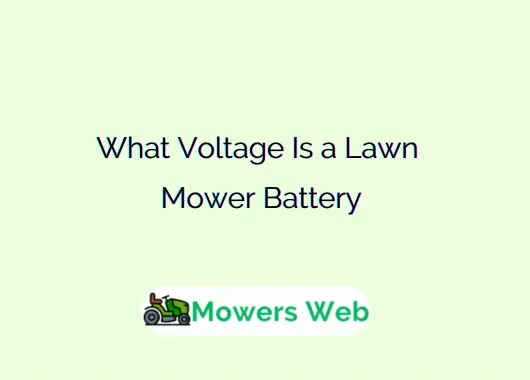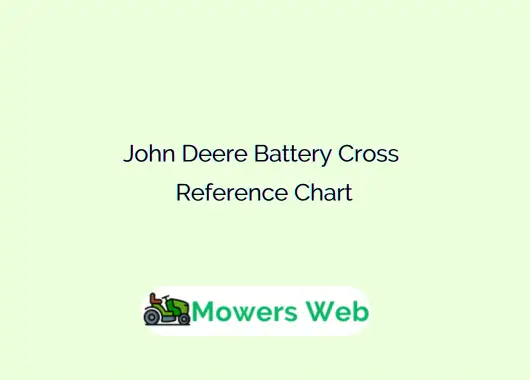The voltage of a lawn mower battery determines its power output, runtime, and suitability for different types of mowing tasks.
In this post, we’ll explore what voltage a lawn mower battery typically is, the types of batteries used, factors influencing voltage selection, and tips for maintaining your lawn mower battery.
What Voltage Is a Lawn Mower Battery
The voltage of a lawn mower battery typically ranges from 12 volts for lead-acid batteries used in gas-powered riding mowers to 36, 40, or 56 volts for lithium-ion batteries in cordless electric push mowers.
Riding mowers commonly use 12-volt batteries to start the engine, while modern cordless mowers rely on 36-volt or 40-volt batteries for small to medium lawns, and 56-volt or higher (e.g., 80-volt) for larger or more demanding tasks.
1. 12-Volt Batteries (Lead-Acid)
Lead-acid batteries are standard in gas-powered riding lawn mowers and some older push mowers with electric start features. These batteries are typically rated at 12 volts, which is sufficient to start the engine or power auxiliary components like lights or ignition systems.
A 12-volt battery is robust, affordable, and widely available, making it a popular choice for riding mowers used on larger lawns or small estates.
However, 12-volt lead-acid batteries are heavier and require regular maintenance, such as checking electrolyte levels and ensuring proper charging to prevent sulfation. They are less common in fully electric mowers, where lighter and more efficient lithium-ion batteries dominate.
Related Rural King Battery Size Chart(Ultimate Size Guide For All Applications)
2. 36-Volt and 40-Volt Batteries (Lithium-Ion)
For cordless electric push mowers, 36-volt and 40-volt lithium-ion batteries are among the most common. These voltages strike a balance between power and portability, making them ideal for small to medium-sized lawns.
A 40-volt battery, for instance, can power a mower capable of cutting through moderately thick grass while offering a runtime of 30 to 60 minutes, depending on the battery’s ampere-hour (Ah) rating and the mower’s efficiency.
Brands like Ryobi, Greenworks, and EGO often use 40-volt systems, which are versatile enough for residential use. These batteries are lightweight, require minimal maintenance, and can often be swapped between compatible tools within the same brand’s ecosystem.
Related EGO Battery Comparison Chart(For All Battery Models)
3. 56-Volt and Higher (Lithium-Ion)
High-performance cordless mowers designed for larger lawns or tougher conditions often use 56-volt batteries or higher. For example, EGO’s 56-volt system is renowned for delivering power comparable to gas-powered mowers, making it suitable for heavy-duty tasks.
Some professional-grade mowers may even use 80-volt or 82-volt batteries, like those from Greenworks Commercial or Kobalt, which offer extended runtime and superior cutting power for large properties or commercial use.
Higher voltage batteries tend to be more expensive, but they provide longer runtimes and can handle demanding conditions, such as wet grass or uneven terrain. However, they may also require longer charging times and specialized chargers.
Related Greenworks Battery Compatibility Chart(For All Models)
4. Dual-Battery Systems
Some advanced cordless mowers use dual-battery setups, where two lower-voltage batteries (e.g., two 40-volt batteries) are combined to achieve a higher effective voltage or extended runtime. These systems are common in robotic or self-propelled mowers, where consistent power delivery is crucial for autonomous operation.
Factors Influencing Battery Voltage Selection
Choosing the right voltage for a lawn mower battery depends on several factors:
- Lawn Size: For small lawns (under ¼ acre), a 36-volt or 40-volt battery is usually sufficient. Larger lawns (½ acre or more) may require 56-volt or higher batteries to ensure adequate runtime and power.
- Grass Type and Terrain: Thick, dense grass or hilly terrain demands more power, making higher-voltage batteries (56V or above) a better choice. For flat lawns with light grass, lower voltages may suffice.
- Mower Type: Push mowers typically use 36-volt to 56-volt batteries, while riding mowers rely on 12-volt lead-acid batteries for starting. Robotic mowers often use specialized lithium-ion packs with varying voltages.
- Budget and Brand Ecosystem: Higher-voltage batteries are pricier, so budget-conscious users may opt for 40-volt systems. Additionally, sticking to a brand’s ecosystem (e.g., DeWalt, Milwaukee) ensures battery compatibility across tools.
Related Will a Lawn Mower run with a Dead Battery(What To do)
Maintaining Your Lawn Mower Battery
To maximize the lifespan and performance of your lawn mower battery, follow these tips:
- Charge Properly: Use the manufacturer’s recommended charger and avoid overcharging. For lithium-ion batteries, partial charging (e.g., to 80%) can extend lifespan.
- Store Correctly: Store batteries in a cool, dry place, away from extreme temperatures. For lead-acid batteries, ensure they’re fully charged before storage to prevent sulfation.
- Clean Terminals: For lead-acid batteries, regularly clean the terminals to prevent corrosion. Use a mixture of baking soda and water to neutralize acid buildup.
- Avoid Deep Discharges: Lithium-ion batteries perform best when not fully discharged. Recharge them when they reach 20–30% capacity.
- Check Compatibility: When replacing a battery, ensure the voltage and physical size match the mower’s requirements. Using an incompatible battery can damage the mower or reduce performance.
Related Ryobi Battery Comparison Chart(All Models Comparison)
FAQs
Are lawn mower batteries 6-volt or 12-volt?
Most lawn mower batteries are 12-volt, especially for gas-powered riding mowers. 6-volt batteries are rare and typically found in older or specialized models.
What is the normal voltage of a lawn mower battery?
The normal voltage is 12 volts for lead-acid batteries in riding mowers and 36, 40, or 56 volts for lithium-ion batteries in cordless electric mowers.
Can you charge a lawn mower battery with a 12-volt charger?
Yes, a 12-volt charger can charge a 12-volt lead-acid lawn mower battery, but ensure the charger is compatible and designed for the battery type.
Can I jump a lawn mower battery with a car?
Yes, you can jump a 12-volt lawn mower battery with a car, but use caution, connect cables correctly, and avoid running the car to prevent overvoltage.
Can you use a car battery for a lawn mower?
A 12-volt car battery can work in some riding mowers if it fits and has similar specs, but it’s not recommended due to size, weight, and compatibility issues.
Final words
The voltage of a lawn mower battery depends on the type of mower and its intended use. For gas-powered riding mowers, 12-volt lead-acid batteries are standard, while cordless electric mowers typically use 36-volt, 40-volt, or 56-volt lithium-ion batteries. Higher voltages, like 80-volt or dual-battery systems, are reserved for heavy-duty or professional-grade mowers.




